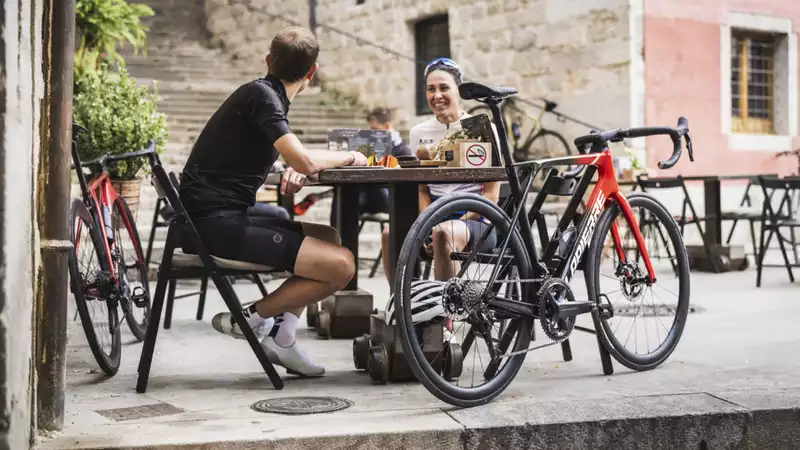In June, just before the Tour de France, the riders of the Groupama-FDJ team got new bikes. At the time, few details about the unreleased Lapierre Xelius SL3 were revealed, but today Lapierre is ready to share all the details as the new bike is now available for consumer purchase.
The third iteration of the Xelius is an evolution: the technology that made the SL2 has been carried over to the SL3. The powerbox, Lapierre's name for the Di2 battery housed in a trapdoor inside the bottom bracket shell, continues to be present in the SL3; it continues to be used in the SL3 to make it smaller and lighter, but the concept of weight reduction remains the same. It also features 3D tubular technology, which joins the seatstays under the top tube.
While 3D Tubular Technology is particularly aesthetically pleasing, Lapierre reaffirms that it is a decision made for comfort and performance, not just for looks, that the rear of the bike is connected by the top tube rather than the seat tube. In terms of comfort, the 27.2mm seat tube provides more flexibility to absorb road sway, and that sway is transmitted to the top tube rather than the saddle. On the performance side, the amount of carbon required to join the seatstays to the top tube has been reduced, resulting in a lighter weight.
The Xelius joins the lineup as Lapierre's answer to the modern climber bike. In contrast to the aero-focused Aircode and the endurance-focused Pulsium, Lapierre describes it as an all-around race bike rather than a pure climbing bike. 32mm tire clearance, for example, is not an unrealistic claim, but it is Lapierre's best There is no doubt that this is a lightweight bike.
Lightweight bikes are not magic. The Zelius SL3 uses new Trekker carbon fiber that is lighter and stronger than the IM T800/HM M40J, VHM YS60, T1000, and the new UD Superlight Innovations carbon technology. However, changing grades of carbon fiber always comes with tradeoffs, and weight savings can also come from increased productivity.
For the SL3, Lapierre has further optimized frame manufacturing. According to Lapierre, during the lay-up phase, new rigid polypropylene mandrels helped make each layer more stable in the mold, resulting in better carbon compression and less resin retention. The result is improved carbon compaction and less resin retention. It also allowed for unique layups for different frame sizes. These details have led to an overall reduction in materials and bike weight.
As a result of the optimization, the Zelius SL3 weighs 725g (±15g) in the light version with an M size uncut finish, while the standard frame weighs 845g with an uncut finish and 893g with a painted finish. In addition to the frame weight, the uncut fork weight is frame-specific sizing, 352g for the Light or Stiff frame kit and 392g for the Standard.
According to Lapierre, the stiffness from the SL2 is maintained, but it does not feel exactly the same The down tube design is new, and the sizes are the same. The downtube design is new and larger in size, as well as sharper edges for increased torsional stiffness. The head tube now features 1.5-inch bearings, and the bottom bracket has also been increased in size. According to the brand, compared to the Xelius SL2 team, the new Xelius SL3 has a stiffer head tube and a 5% softer bottom bracket.
Modern bikes of all kinds boast improved aerodynamics, and Lapierre is following this trend by focusing on aerodynamics in the Zelius SL3. The design team used CFD and wind tunnel testing to optimize the NACA and KAMMTAIL tubes in the down tube, seat tube, and seat stays. They also integrated the front end cables and hoses while improving the aero profile of the fork and head tube.
The result is a bike that can provide impressive gains if you go fast enough. There is a 1 percent difference at 40 km/h and an 8.5 percent difference at 60 km/h. The wind angle covers up to 20 degrees, although no mention is made of speeds below that. The effect is likely to be more noticeable on downhills and in crosswinds, but there is no downside since there is no increase in weight.
The goal here is to improve aerodynamics and accuracy in high-speed descents. On the Xelius SL3, Lapierre wants a more streamlined and prominent front of bike position. As for cornering, the goal is to be faster and more precise. [To achieve these goals, the geometry of the new Zelius SL3 is derived from the Aircode DRS, a dedicated aero bike. This means that the major changes are an 8-13 mm longer reach and a top tube that is 2-4 mm shorter, depending on size. Along with this change, the SL3 has a 1-degree higher seat angle than the SL2, which moves the rider forward into a more aggressive position.
.

Comments